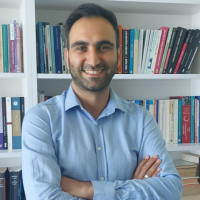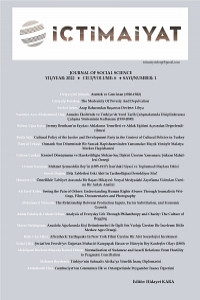Research Article
Book Review
Issue Editorial Board






Aim & Scope
It is a international refereed journal published twice a year. The main purpose of the journal is to contribute to the publication of qualified academic studies in the field of social sciences.
The manuscripts submitted to the journal should be original, unpublished or not submitted for publication. The authors should agree on the order of names.
The legal responsibility of all published articles belongs to the author.
The Journal of İçtimaiyat has the right to make corrections, accepts or rejects the submitted articles.
Journal of İçtimaiyat accepts articles in the fields of History, Literature, Sociology, Philosophy, and Political Sciences.
Author Guidelines
Page Layout
- İçtimaiyat is published biannually in May, and November starting from 2017 by Hidayet Kara (Ph.D.). The purpose of the journal is to make contributions to publishing qualified academic studies in social sciences and humanities
- Manuscripts should be submitted in MS Word 2007 or later.
- Page sizes should be arranged as follows: Paper size:
A4 Vertical,
Top Space: 2,5 cm, Bottom Margin 2,5 cm, Left Margin: 2,5 cm, Right Margin: 2,25 cm,
Top of Pragraph 1 cm,
Block Quote 1 cm (Right and left),
Font Calibri Body,
Font Style Normal,
Main Text Size 11th,
Block Quote Text Size 10 th, Font Style İtalic
Footnote Test Size 10 th.
- The articles should include the name(s), surname(s), institutional title(s), institution name(s), e-mail address(es), and ORCID of the author(s). In addition, the corresponding author has to be indicated in the articles.
- The title of the article has to be consistent with the content and must reflect the content in the best way possible. The title has to be boldface with a font size of 12. The first letter of all the words has to be uppercase. The title has to be center-aligned. The articles should have an English title with the same properties.
- At the beginning of the article, there should be an “Abstract” in Turkish which consists of at least 100 words and at most 160 words which express the subject in a concise manner. References, figures and table numbers should not be mentioned in the abstract. At least 5 key words should be given with one line space under the abstract. Keywords should be consistent with the content of the article and should be inclusive. Similarly, the articles should include an English title, keywords, and abstract. If the article is written in English, the Turkish abstract is not necessary.
- The language of the publication is Turkish or English.
- The works presented in any symposium or congress can be published by specifying the name, place and date of the congress. In studies supported by a research institution or fund, the name and project number of the support organization should be given.
- The study must comply with the grammar rules. In the use of punctuation marks in the article, the last TDK Writing Guide should be taken as a basis in writing the words and abbreviations, a clear and simple way of expression should be followed and unnecessary information beyond the scope and purpose should not be included. Scientific methods should be followed in the preparation of the article, subject, purpose, scope of the study, the reason for preparation and so on. Information should be provided to a sufficient extent and in a specific order.
- An article should include abstract, sections of the main text, bibliography and appendices (if any). The article should have an “Introduction” and a “Conclusion” section. “Introduction must include the purpose, importance, period, scope, data methodology and plan of the study. If necessary, the literature discussion can be given in this section. The “conclusion should be appropriate to the purpose and scope of the research and should be outlined and concise. The issues not mentioned in the text should not be included in the conclusion. Main, intermediate and subheadings can be used to provide a certain order.
- Tables / Figures should contain a number and a title. Vertical lines should not be used in tables. Horizontal lines should only be used to separate subheadings within the table.
- Only the first letters of the titles should be capitalized. As mentioned above, other titles except the main title should be set to be 6 nk before and after. Block quotations should be given as a separate paragraph, with 10 font size and 1margin on the left and right side in quotation marks and in italics.
- Heading Numbering:
Giriş
1………………………………
1.1…………………………….
2………………………………
2.1…………………………….
2.1.1…………………………..
2.1.2…………………………..
3……………………………….
3.1……………………………..
- The bibliography should be written with one-line spacing, hanging with 1 cm and 10 font size.
Sample Bibliograph
(i) Book:
Meriç, C. (2009). This country. Istanbul: Communication Publications.
(ii) Translation book:
Davison, A. (2006). Secularism and Modernity in Turkey. (trans. Tuncay Birkan). Istanbul: Communication Publications.
(iii) Review book:
Duran, B. (2005). Civil Society and Politics in Turkey. Civil Society: Different Perspectives, Jun. Contact Lütfi directly Istanbul: Kaknüs Yay.
(iv) Article:
Yilmaz, F. (2003). Economics and Sociology: The Fight of Domination of Competing Brothers. Society and Science, 95, 61-84.
(v) Article with double authors:
Yaslıçimen, F., & Sunar, L. (2006). Ibn Khaldun as a Possibility of Renewal in Social Sciences. Journal of Islamic Studies, 2 (16), 137-167
(vi) Theses
Kara, H. (2013). The Ottoman Army in Period of Abdulhamid II (1876-1908), Ph.D. Thesis. Erzurum: Atatürk University.
In-text citations should be given in parentheses in the related section.
(i) For Single Author: (Surname, Publication Year: Page Number)
(ii) For Multiple Authors: (Surname et al., Publication Year: Page Number)
Ethical Principles and Publication Policy
The authors who will send articles to İçtimaiyat should scan their articles in one of the plagiarism programs (İthenticate or equivalent) and upload the similarity report to the system together with the article.
Journal editorial boards can scan articles for plagiarism.
The similarity ratio should be less than 15%, excluding footnotes and the bibliography.
İçtimaiyat uses the ithenticate program for the similarity report.
Price Policy
The Journal of İçtimaiyat does not charge any fees during the publication process.
Içtimaiyat is licensed under a Creative Commons Attribution-NonCommercial 4.0 International License (CC BY NC).
Instagram: @tvictimaiyat X: @IctimaiyatD





